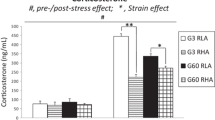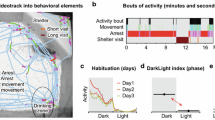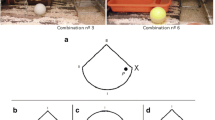Abstract
The first experiment was designed to determine what proportion of the betweenstrain variation in rate of avoidance learning could be attributed to strain differences in sensitivity and response topography to electric shock. Measures of jumping at six shock intensities for four inbred strains were collected in a pretest of shock sensitivity. They were then used to derive a shock intensity for each strain which yielded the same amount of jumping for all strains. Avoidance training was administered to other mice of the same age and strains using the same apparatus and shock source as in the pretest. When training was given with a 180 μa shock, significant strain differences were observed in latency of the first escape and total errors to a learning criterion during both jump-out and one-way avoidance training. A large strain by training procedure interaction was found, as well. When training was administered with shock levels which yielded equal jumping in the pretest, strain differences in latency of the first escape were totally eliminated. However, the magnitude of strain differences in the rate of avoidance learning was not changed substantially. A second experiment examined two F1 hybrid strains and a four-way cross of the inbred strains tested in the first experiment. Results indicated that initial response to shock is characterized by intermediate inheritance, while rate of avoidance learning exhibits significant dominant inheritance. Although significant genetic differences in both initial response to shock and rate of avoidance learning were detected in the present experiments, it is concluded that the former cannot account for the latter.
Similar content being viewed by others
References
Bolles, R. C. (1970). Species-specific defense reactions and avoidance learning.Psychol. Rev. 77: 32–48.
Bonaventure, N., and Karli, P. (1961). Sensibilité visuelle spectrale chez des souris à rétine entièrement dépourue de cellules visuelles photoréceptrices.Compt. Rend. Soc. Biol. 155: 2015–2018.
Bovet, D., Bovet-Nitti, F., and Oliverio, A. (1960). Effects of nicotine on avoidance conditioning of inbred strains of mice.Psychopharmacologia 10: 1–5.
Bovet, D., Bovet-Nitti, F., and Oliverio, A. (1969). Genetic aspects of learning and memory in mice.Science 163: 139–149.
Carran, A. B. (1967). Passive avoidance and strain differences associated with differences in emotionality: A test of Mowrer's theory.Psychon. Sci. 7: 263–264.
Carran, A. B., Yeudall, L. T., and Royce, J. R. (1964). Voltage level and skin resistance in avoidance conditioning in inbred strains of mice.J. Comp. Physiol. Psychol. 58: 427–430.
Cole, H. F., and Wolf, H. H. (1969). A pharmacological evaluation of a genetically predisposed conditioned avoidance response.Proc. Soc. Exptl. Biol. Med. 132: 1067–1071.
Collins, R. L. (1964) Inheritance of avoidance conditioning in mice: A diallel study.Science 143: 1188–1190.
Duncan, N. C., Grossen, N. E., and Hunt, E. B. (1971). Apparent memory differences in ‘inbred’ mice produced by differential reaction to stress.J. Comp Physiol. Psychol. 74: 383–389.
Falconer, D. S. (1960).Introduction to Quantitative Genetics, Ronald Press, New York.
Frank, R. and Kenyon, J. (1966). Visual cliff behavior of mice as a function of genetic differences in eye characteristics.Psychon. Sci. 4: 35–36.
Fuller, J. L. (1966). Variation in effects of chlorpromazine in three strains of mice.Psychopharmacologia 8: 408–414.
Hays, W. L. (1963).Statistics for Psychologists, Holt, Rinehart and Winston, New York.
Henry, K. R., and Schlesinger, K. (1967). Effects of the albino and dilute loci on mouse behavior.J. Comp. Physiol. Psychol. 63: 320–322.
Jensen, A. R. (1969). How much can we boost IQ and scholastic achievement? InEnvironment, Heredity, and Intelligence, Harvard Educ. Rev., Reprint Series No. 2, pp. 1–123.
Kimble, G. A. (1961).Hilgard and Marquis' Conditioning and Learning, Appleton-Century-Crofts, New York.
King, J. A., and Mavromatis, A. (1956). The effect of a conflict situation on learning ability in two strains of mice.J. Comp. Physiol. Psychol. 49: 465–468.
Lerner, I. M. (1954).Genetic Homestasis, Oliver and Boyd, Edinburgh.
Lund, R. D. (1965). Uncrossed visual pathways of hooded and albino rats.Science 149: 1506–1507.
McClearn, G. E. (1967). Genes, generality, and behavior. In Hirsch, J. (ed.),Behavior-Genetic Analysis, McGraw-Hill, New York.
Mowrer, O. H. (1947). On the dual nature of learning: A reinterpretation of “conditioning” and “problem solving”.Harvard Educ. Rev. 17: 102–148.
Newell, T. G. (1970). Three biometrical genetic analyses of activity in the mouse.J. Comp. Physiol. Psychol. 70: 37–47.
Oliverio, A. (1967). Effects of different conditioning schedules based on visual and acoustic conditioned stimulus on avoidance learning of two strains of mice.J. Psychol. 65: 131–139.
Roberts, L. E. (1967). Central, peripheral, and artifactual determinants of skin resistance in the mouse.J. Comp. Physiol. Psychol. 64: 318–328.
Rose, A., and Parsons, P. A. (1970). Behavioural studies in different strains of mice and the problem of heterosis.Genetics 41: 65–87.
Royce, J. R., and Covington, M. (1960). Genetic differences in the avoidance conditioning of mice.J. Comp Physiol. Psychol. 53: 197–200.
Schlesinger, K., and Wimer, R. (1967). Genotype and conditioned avoidance learning in the mouse.J. Comp. Physiol. Psychol. 63: 139–141.
Seligman, M. E. P. (1970). On the generality of the laws of learning.Psychol. Rev. 77: 406–418.
Theios, J., Lynch, A. D., and Lowe, W. J., Jr. (1966). Differential effects of shock intensity on one-way and shuttle avoidance conditioning.J. Exptl. Psychol. 72: 294–299.
Thompson, W. R. (1954). The inheritance and development of intelligence.Proc. Ass. Res. Nerv. Ment. Dis. 33: 209–231.
Wimer, R. E., Symington, L., Farmer, H., and Schwartzkroin, P. (1968). Differences in memory processes between inbred mouse strains C57BL/6J and DBA/2J.J. Comp. Physiol. Psychol. 65: 126–131.
Wolf, H. H., Swinyard, E. A., and Clark, L. D. (1962). The differential effects of chlorpromazine and pentobarbitol on two forms of conditioned avoidance behavior inPeromyscus maniculatus gracilis.Psychopharmacologia 3: 438–448.
Zerbolio, D. J., Jr. (1967). Differences between three inbred mouse strains on a wheel-turn avoidance task.Psychon. Sci. 7: 201–202.
Author information
Authors and Affiliations
Additional information
This research was supported in part by Grant APA-398 from the National Research Council of Canada.
Rights and permissions
About this article
Cite this article
Wahlsten, D. Phenotypic and genetic relations between initial response to electric shock and rate of avoidance learning in mice. Behav Genet 2, 211–240 (1972). https://doi.org/10.1007/BF01065691
Received:
Accepted:
Issue Date:
DOI: https://doi.org/10.1007/BF01065691




